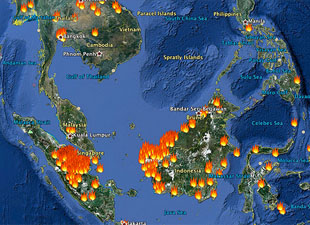
AsianScientist (Apr. 3, 2013) – By Mike Ives – A new study offers fresh estimates of the economic and social impacts of dengue fever in South-East Asia and one country in South Asia. But an expert on the disease says that the actual figures could be higher, as data is limited by a lack of reporting of cases by health officials in the countries studied and the limited resources put into surveillance.
The two-part study, published last month (February 21) in PLOS Neglected Tropical Diseases, estimates that there are 2.9 million annual dengue infections and nearly 6,000 deaths across an area spanning Bhutan, East Timor, and all ten members of the Association of Southeast Asian Nations.
Dengue’s annual disease burden is about 370 disability adjusted life years for every million inhabitants of South-East Asia, which translates as a cost of US$1.65 per person, the study reports.
Its economic and disease burden is higher than those of hepatitis B, Japanese encephalitis and 15 other conditions, the study says.
Even so, Duane Gubler, founding director of the Emerging Infectious Diseases program at Duke-NUS Graduate Medical School Singapore, a collaboration between Duke University in the United States and the National University of Singapore, says the research “grossly underestimates” dengue’s disease burden in the region.
The biggest limitation is the poor surveillance data the researchers had to work with, he tells SciDev.Net.
Gubler says that part of the problem is that countries in South-East Asia rely too much on international donors to fund dengue research projects, which breeds dependence.
“If we’re ever going to control a disease like this, we need investment by the countries themselves,” he says.
Eduardo A. Undurraga, a graduate student at Brandeis University, United States, and a co-author of both studies, acknowledges this limitation, and highlights several others.
For example, he says, the study did not measure people who are turned away from hospitals during dengue epidemics or those who die from other conditions after catching dengue.
There are also the economic costs caused by tourists deciding against traveling to a particular country because of concerns about catching dengue, he adds.
“If I know Thailand has a serious dengue outbreak, I would think twice about going there,” Undurraga says, by way of offering a hypothetical example.
Most of the 50 million people infected by dengue fever each year live in developing countries in the tropics and subtropics.
Gubler says that dengue receives comparatively little attention from international donors and governments relative to HIV/AIDS, malaria, tuberculosis and other high-profile diseases. Part of the reason, he suggests, is that it has comparatively lower fatality rates.
There is no specific treatment for the disease, but the French company Sanofi Pasteur has said it plans to launch the world'[s first dengue vaccine by 2015.
The articles can be found at:
Shepard DS et al. (2013) Economic and Disease Burden of Dengue in Southeast Asia.
——
Source: Science and Development Network; Photo: naturegirl 78/Flickr/CC.
Disclaimer: This article does not necessarily reflect the views of AsianScientist or its staff.












